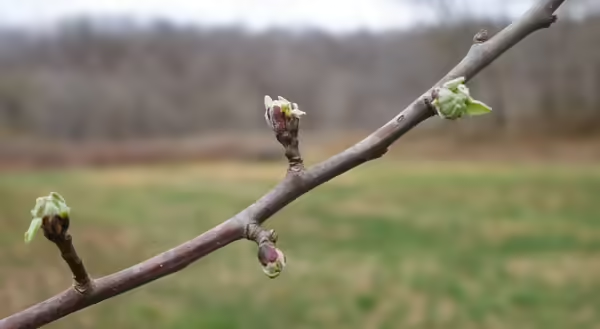
This year has certainly hosted an interesting spring, with bouts of summer-like weather followed by freezing temperatures and frost warnings. From the emerging wildflowers in woodlands to daffodils and tulips in the home landscape, there is no shortage of spring blooms to stimulate gardeners. Just this week, I am starting to notice hosta leaves pushing through the soil surface, along with tons of other perennials in my garden beds.
The tiny spring sprouts and ample spring blooms always motivate gardeners to get busy this time of year. As we start to make the rounds it is always very tempting to prune woody plants in the process. However, pruning during spring bud break or flowering can be an incredibly damaging practice for trees and shrubs.
Why pruning in spring can be damaging
As with herbaceous vegetation, the spring awakening for woody plants is an energy-intensive process. The first sign of this energy investment can be seen in swelling buds, indicative of the coming leaves or flowers. Pruning after bud break removes these plant structures, removing energy from the plant at the same time, which can ultimately impact plant growth and vigor in the coming year, especially on an already stressed plant.
Woody plants rely on collectively stored energy in roots, buds, stems, and other plant tissues to break dormancy and begin growth for the year. This energy was generated the previous year as leaves photosynthesized to produce energy-infused sugars. Although many of these sugars are used for the immediate needs of the growing season, a healthy woody plant is able to produce sugars beyond the daily demand. This excess energy is stored away to fuel next year’s spring awakening.
The annual energy production of woody plants is often explained in terms of a savings account. During summer, as leaves are actively photosynthesizing, energy is being stored away or saved. As fall time rolls around, trees save every penny to squirrel away for winter. Although they may make a withdrawal from their savings account to perform the energy-intensive process of leaf drop, they make sure to remove every last bit of energy possible from leaf structures and put it in savings before leaf drop.
When spring rolls around, it is time for a major withdrawal to invest in the plant parts that will fund energy production during the coming growing season. The start of this energy investment can be observed as buds begin to swell.
Flowering is a costly process as well that will demand a large spring withdrawal. After all, the process of flowering, pollination, and subsequent fruit production is what perpetuates a species. In the grand scheme of things, it’s well worth the energy investment!
Pruning in spring removes a large amount of a woody plant’s savings before it can replenish those funds with its new crop of leaves. The general recommendation this time of year is to wait until leaves have fully developed and had a chance to photosynthesize a bit (around mid-June), making a return on their initial investment. Or, prune earlier in the year, prior to bud break.
The best time to prune
Overall, the best pruning strategy is to wait until winter dormancy. During winter, your plant has stored as much energy as possible, and the plant parts removed will ultimately have less impact on your tree’s bank account.
The bottom line is that you can prune off a troublesome limb or two this spring but realize that your plant’s annual budget is taking a loss from the energy you removed. If earnings from last year can absorb that loss, it may not be a big deal. In many cases, I would say to prune away on a few limbs but keep cuts to a minimum. However, if your plant was stressed last year or you plan to prune the entire canopy, you may be removing more than your plant can afford this spring.
Photo Caption: The buds on this apple tree have started to open up, indicating the winter pruning window has closed. Photo by Ryan Pankau.